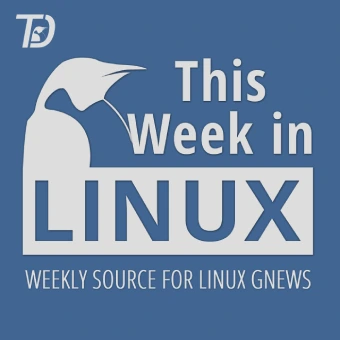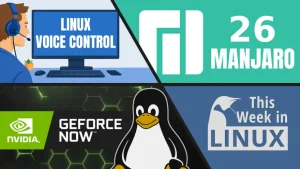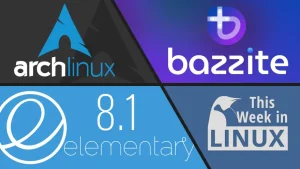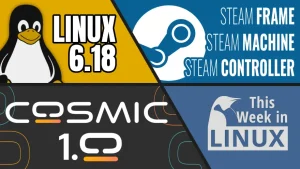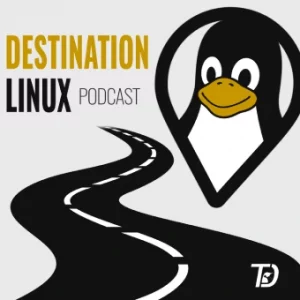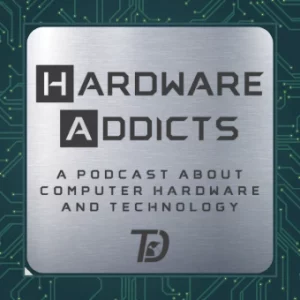This week in Linux, we’ve got a lot of GNews. Vanilla OS 2.0 has finally shipped after more than a year of development and it’s got my attention. Serpent OS have also released a PreAlpha release of this new independent distro from the creator of Solus. Then we’ve got some more updates about the COSMIC desktop since it’s less than a week away. All of this and more on This Week in Linux, the weekly news show that keeps you up to date with what’s going on in the Linux and Open Source world. Now let’s jump right into Your Source for Linux GNews!
Want to Support the Show?
Become a Patron = https://tuxdigital.com/membership
Store = https://tuxdigital.com/store
Chapters:
00:00 Intro
00:40 COSMIC Alpha is so close
02:09 Vanilla OS 2.0 Released
05:43 Serpent OS Prealpha0 Released
09:02 Sovereign Tech Fund introduces fellowship pilot program
11:26 Gear Lever for AppImages
13:46 Funtoo Linux is being discontinued
15:35 DreamWorks’ OpenMoonRay 1.6 Released
17:13 Outro
Links:
- COSMIC Desktop is so close
- Vanilla OS 2.0 Released
- Serpent OS Prealpha0 Released
- Sovereign Tech Fund introduces fellowship pilot program
- Gear Lever for AppImages
- Funtoo Linux is being discontinued
- DreamWorks’ OpenMoonRay 1.6 Released
Transcript
Michael:
[0:00] This week in Linux, we’ve got a lot of GNews for you. Vanilla OS 2.0 has finally shipped after more than a year of development, and it’s got my attention. Also, SerpentOS have also released a pre-alpha of this new independent distro from the creator of Solus. Then we’ve got some more updates to talk about with the COSMIC Desktop, since it’s less than a week away. All of this and more on This Week in Linux, the weekly news show that keeps you up to date with what’s going on in the Linux and Open Source world. And let’s jump right into Your Source for Linux GNews.
Michael:
[0:40] A few days ago, I was able to attend a small press conference by System76 where they demoed their new desktop environment, COSMIC. And I got to say, it is looking very, very promising. And I’m excited to be giving it a shot very soon. The alpha release of the COSMIC Desktop is less than a week away. You can download the alpha version of Pop!OS that comes with the alpha version of COSMIC Desktop this Thursday, August 8th. They demoed a bunch of cool features that they have had added to the desktop and afterwards they gave us the opportunity to ask whatever questions we wanted to.
Michael:
[1:15] And there were many people involved in this call. And I think I might have gotten them tired of me because I was asking so many questions. I believe about half of the questions that were asked were asked by me. So anyway, the desktop is looking very promising and I can’t wait to check it out. There are a ton of nice features that they showed off that you get polished right out of the box. But there’s also a lot of power user features. For example, you can have multiple different configurations of your workspaces, and you can have different workspaces based on different monitors. And the same thing with your panels. You can have different panel layouts on different monitors, and you can have any configuration of high DPI or small screens or vertical and horizontal screens and all sorts of stuff. And that’s just talking about the monitors. There’s so many other things.
Michael:
[2:05] And I’ll show you all about it next week when the alpha drops. Are you looking for a new distro to try? do you have a sweet tooth? Well, you’re in luck because Vanilla OS 2.0 Orchid has been released. What is Vanilla OS, you ask? Well, Vanilla OS is a Debian-based immutable style distro that they claim will be your next operating system. It’s right there on the homepage, your next operating system.
Michael:
[2:31] Vanilla OS 2.0 has been in the works for quite some time now. Well, over a year since they they announced that they were going to switch away from Ubuntu to Debian. So there’s quite a lot to talk about with this release. As I said, Vanilla OS 2 is now built on Debian with Linux 6.9 and GNOME 46. And more notably, it’s Debian Sid. So it’s a very interesting thing to do because they’re taking the unstable, and by unstable, I mean, that’s literally what they call it, the unstable version of Debian and making an immutable distro from this, which is just intriguing to me. The reason they said that they are switching away from Ubuntu is to provide a more vanilla GNOME experience, skip Snap-related package issues, and not be attached to Ubuntu’s release schedule so they can release whenever they want to.
Michael:
[3:19] This change is pretty massive shift, which is why it has been a long development road from 1.0 to 2.0. And this rewrite brings a bunch of new features and integrations and security improvements. And of course, Vanilla OS 2 is keeping the immutable Linux distribution structure made possible by their homegrown AB root utility. Now, this provides full immutability and atomic features, transacting between two root file systems and updates using OCI images. Vanilla OS 2.0 also lets you install packages from other Linux distros using the distro box-based APX utility. This new release also provides a GUI so that you can create custom environments, add also custom configurations. You can add development stacks, control subsystems, and more things. The Vanilla OS team didn’t stop there. They’ve introduced an experimental support for Android apps via WayDroid in 2.0. So you can sideload APKs or you can get apps from F-Droid. Plus, there’s a new vanilla installer that handles the job of installing the OS for new users or OEMs, which also integrates recovery options and has support for encrypting the /var partition with LUKS2.
Michael:
[4:34] Then once you have it installed, you’ll be presented with a welcome app on the first run for user account creation, setting up a web browser and many more things. They also made a new tour app to show users around the new features and that sort of stuff, which is a great idea.
Michael:
[4:50] For some very technical highlights in Vanilla OS 2.0, you get LVM thin provisioning, polkit policies replace sudo with secured privileged opera operations, FS guard and FS warn, boot time system integrity checks, support for dual GPU switching.
Michael:
[5:07] Vanilla image builder or VIB OCI recipe system, and more. Vanilla OS has been on my radar for quite a while because it offers some really cool ideas and features, especially with the fully embracing of the Immunables and Assessment Management. And I’m very interested in this. The Vanilla OS 1.0 was interesting, but it had been a long time. And I also figured what’s the point of doing the testing now when the base is going to be so different later. So that’s why I waited. And I’m very curious. Are you going to try it out? Let me know in the comments below. and if you’re interested, you’ll find links in the show notes.
Michael:
[5:43] There’s a new distro that might be slithering onto your machine soon.
Michael:
[5:47] Serpent OS is finally getting a release, although it’s a pre-Alpha Zero release, as they described it. So it’s more like a technical preview than a release. Aiki Doherty is back in the Linux distro development game with this long-anticipated Serpent OS distribution. For those that don’t know, Aiki was the founder of Solus and has been developing Linux-based distros for many years. The goal for Serpent OS is to provide Linux community with a truly modern distribution for people who want to just use Linux. As they say. This pre-alpha of SerpentOS is coming with GNOME as the default desktop environment using GNOME 45.3. SerpentOS offers a minimal GNOME desktop experience with only a handful of apps pre-installed, such as the Mozilla Firefox web browser, GNOME console terminal, GNOME text editor, the Z code editor, and GNOME’s loop image viewer, as well as some GNOME extensions, or at least the support of GNOME extensions. Now, SerpentOS is planning to support Flatpaks out of the box when it fully releases later, but this pre-alpha does not include Flatpak support yet. The GNOME desktop is kept very clean in this pre-alpha. In fact, there’s only one GNOME extension enabled by default for enabling app indicators, also known as system tray menus.
Michael:
[7:07] This is of course, because for some unknown reason, and, well, unknown to everyone, I guess, except GNOME, they got rid of support for system tray menus about 10 years ago. And unsurprisingly, practically everyone still uses them. Of course, you can also install other GNOME extensions that you want to do, but I appreciate them addressing this needlessly glaring issue in GNOME, even in a pre-alpha.
Michael:
[7:34] Now, the pre-alpha is not meant to be tested by everyone. SerpentOS does not yet have a graphical installer. Right now, it comes with a command line installer that can be accessed from the terminal, and it also will require the user to do manual partitioning to install. Though this can be forgiven for a pre-alpha stage, since it is clear it is far from ready for production use, for those who are wondering which distro SerpentOS is based on, well, none. None. Just like Solus, iKey has decided to build SerpentOS as an independent distribution written from scratch. This means it will come with its own package management tool called MOS, which is written in Rust, and SerpentOS has its own package repository. One of the cool features of MOS will be the support for offline rollback of packages, which is very cool. For those who don’t know, iKey is a fan of the rolling release model. So naturally, just like Solus, SerpentOS OS will be a rolling release, so you can install once and update forever. This kind of release model usually means having the latest packages available and with the pre-alpha release being powered by the Linux 6.10 kernel, that seems to be the case here. IKey has stated to 9to5linux.com that Serpent OS will be offering more desktop environment options in the future, including KDE Plasma and even System76 New COSMIC Desktop, which is very cool. If you’d like to learn more about SerpentOS or try out the pre-alpha,
Michael:
[9:00] you’ll find a download link in the show notes.
Michael:
[9:02] Open Source software is a wonderful thing, but sustainability of projects has always been an issue for the community. A really cool project might be started and you jump into it to help improve it so you can make it better to enjoy all the benefits it offers. And then all of a sudden, the main developer just vanishes with no warning and no message. I had this very thing happen to me, in fact, multiple times. But back in the day, there was a really cool project that I joined, and then out of nowhere, it was gone. I never spoke to that dev again. It was very weird. But now imagine this kind of thing happening with an Open Source project that is like a backbone of various different kinds of infrastructure.
Michael:
[9:44] This kind of thing can and does happen, which is why the Sovereign Tech Fund is such a great organization. The Sovereign Tech Fund has has been helping to fund various different kinds of Open Source projects, including funding the Gnome desktop, about 1 million euros.
Michael:
[10:00] Fantastic. And you could be happy with that, you know, just that with what the Sovereign Tech Fund has done already, but they’ve decided to do one better. They are introducing a new fellowship program that’s a pilot program for maintainers. This fellowship program is to support, as they put it, the dedicated individuals who keep our digital infrastructure running. They also say that over the past two years, STF has successfully contracted over 40 FOSS projects, enhancing their technical sustainability through targeted milestones. However, the activities of maintainers, who often work on multiple FOSS projects, are hard to quantify for funding applications, as the demands and challenges vary and can change quickly. This is where the fellowship for maintainers comes into play. End quote. Now, the Sovereign Tech Fund will start accepting fellowship applications by the end of this quarter, and then they will announce the selected maintainers in quarter four or Q4. I hope this new fellowship works out for the developers and for the Sovereign Tech Fund, because this is such a great thing for Open Source as a whole in general, because maybe this will even make other organizations follow in the footsteps of the STF. And of course, you know, thank you so much to the Sovereign Tech Fund for doing all that you do. And also, yeah, of course, to the projects who are doing all the stuff that you’re doing.
Michael:
[11:23] Because that’s, well, who else would they be funding if the projects didn’t exist, right? Universal formats on Linux are great. We got Flatpaks and Snaps and AppImages. I don’t really care what format an app developer uses, as long as they let me use their app on Linux.
Michael:
[11:38] But with AppImages, I’ve always had a love-hate relationship with them. AppImages are great because you can find an AppImage, download it, and run it. No need to integrate into your system. But what if you want to update that AppImage? Well, you can’t since it’s not integrated into your system. And you have to go download a new version of it since the format itself doesn’t offer the option to download. And also, how do you know that it’s available? Because the option is to be notified for new versions is not available either. I mean, some AppImages will notify you, but that’s because the developer of the AppImage built that in themselves, not the format. mat. Another cool thing is that you can download these AppImages and put them anywhere you want to and run them directly from where you put them. It doesn’t matter even on a flash drive or your desktop or some random folder you want to put it in. But what if you forget where you put them? And even if you don’t, you still have to open your file manager and then navigate to that folder and then launch them from that folder. I guess unless you clutter up your desktop with AppImages.
Michael:
[12:46] So I guess that’s an option. But all of the universal formats have issues. But for me, I think AppImages go a little bit of an extra mile on there. There have been projects made to fix these kinds of things like AppImageLauncher, but that hasn’t had any development since last year. And the GitHub page hasn’t had a new release of it since 2020. So a bit of an issue there. Well, this week I saw a post on the OMG Ubuntu website that really piqued my interest. Let me introduce you to Gear Lever.
Michael:
[13:17] Gear Lever is a simple app to streamline managing, configuring, and even updating AppImages. You can integrate AppImages into your app menu, organize your AppImages into a custom folder. It can help you with managing updates to either replace or keep multiple versions of an AppImage, and much, much more. I’ve not had a chance to test it myself, but I’m definitely excited to give it a shot.
Michael:
[13:40] I also like how you install this app because Gear Lever is available as a Flatpak in the Flathub.
Michael:
[13:46] Speaking of Open Source sustainability, we have a little bit of some bummer news to talk about. Funtoo Linux has been discontinued. Daniel Robbins, founder of the Gentoo Linux distribution and its spinoff Funtoo Linux, has announced that he has decided to end the Funtoo project.
Michael:
[14:03] Daniel said in the announcement that Funtoo started as a philosophy to create a fun community of contributors building something great together. For me, it’s no longer that, so I need to move on to other things. There is not a successor, BDFL, which has been a benevolent dictator for life, or Funtoo, nor am I interested in trying to find one or hand the project off to someone else. You can expect the project to wind down through August. If you have a Funtoo container, it will continue to be online through the end of August. So you have time to find another hosting solution if you need one. So this is definitely a bummer.
Michael:
[14:38] I’m sorry to see that Funtoo is going away. way. Daniel has made a lot of cool stuff, like even founding Gentoo and then Funtoo. So this is a bummer, but I wish him well. If this isn’t the same kind of thing of what I was talking about, how you just wanted to do something else, then it makes sense. That’s one of the things about Open Source, like I talked about earlier with the STF, where the Sovereign Tech Fund is helping projects continue to exist, and they just haven’t started that yet. So if you are a Funtoo user, then let me know in the comments which distro you plan to switch to i’m very curious and to daniel um I understand completely because you know sometimes you just want to move on and I appreciate the fact that you actually made an announcement rather than just vanishing that’s happened to me many times so I appreciate that uh and if you would like to learn more about fun 2 or gen 2 or anything like i’ll have a bunch of links in the comments but uh.
Michael:
[15:34] That’s a bummer. DreamWorks Animation has announced the latest release of their open-source, award-winning, state-of-the-art production MCRT renderer, Moonray.
Michael:
[15:45] Yes, that DreamWorks. The studio that made How to Train Your Dragon, The Boss Baby, Shrek, Kung Fu Panda, and so many more, they are big into open-source. And a couple years ago, they blew everyone’s mind when they announced that they were open-sourcing their Moonray renderer. So Moonray includes an extensive library of production-tested, physically-based materials, a USD Hydra render delegate, multi-machine rendering, and a cloud rendering system via the Ares distributed computation framework. The latest release of Moonray 1.6 added a lot of new features, like improving adaptive light sampling, added new fisheye camera, and added initial support for Apple Silicon, which is just really cool. So if you wanted to render on M-series Macs with macOS Sonoma, you can do that now. Of course, for us Linux users, you could always use Moonray on Linux. That’s kind of their thing, too. In fact, Linux is involved a lot in DreamWorks. If you’d like to know how much, well, check out the interview I had with Randy Packer of DreamWorks on Destination Linux 352. That’s right. You’ll find a link in the show notes for an episode where I interviewed Randy Packer of DreamWorks about all the stuff they do with Open Source, with Moonray, with Linux, with the movies in general. It was a fantastic, it was a really fun interview. Go check it out. Destination Linux 352.
Michael:
[17:13] Thanks for watching this episode of This Week in Linux. If you like what I do here on the show and want to be kept up to date with what’s going on in the Linux and Open Source world, then be sure to subscribe. And of course, remember to like that smash button.
Michael:
[17:27] If you’d like to support the show and the Tux Digital Network, then consider becoming a patron by going to tuxdigital.com/membership, where you can get a bunch of cool perks like access to patron-only sections of our Discord server and much, much more. You can also support the show by ordering the Linux is Everywhere t-shirt or the This Week in Linux shirt at tuxdigital.com/store. Plus, while you’re there, check out all the other great stuff we have like hats, mugs, hoodies, and more at tuxdigital.com/store. I’ll see you next time for another episode of Your Source for Linux GNews. Thanks again for watching. I’m Michael Tunnell. I hope you’re doing swell. Be sure to ring that notification bell. And until next time, I bid you farewell.
